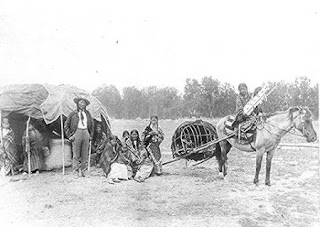What Is: a Travois
As long as people have had a need to move household goods and other possessions from place to place in an efficient manner, they have come up with ingenious ways of doing so. For the Plains tribes of North America, the travois was a handy way of moving tipis, poles and hides, as well as household goods, trade goods, furs and other necessities from one campsite to another.
The word travois comes from a French Canadian word referring to a harness used for beasts of burden, which is essentially what a travois is. It's two poles lashed together in an A-frame and placed across the back of an animal. A third pole or piece of hide is sometimes strung toward the bottom of the frame both to hold it steady and to accommodate the load. The first beasts of burden were dogs, which could only carry small bundles, due to their size and weight. Once horses became part of Plains culture, Native families could construct larger travois, sometimes in a H-formation, and use them to carry tipi poles and hides, as well as more trade goods or furs, or household possessions. Small children could also ride in a travois when on the trail. Just as wagon wheels rutted familiar roads, some Native trails today bear the imprint of travois, such as the Lewis and Clark Trail where it follows the Nez Perce Trail near what is now Pomeroy, Washington.
Just as European Americans adopted canoes in the eastern frontier as an easy method of transport, traders, trappers and explorers sometimes adopted the travois. Because of its light construction and flexibility, the travois could go where wheeled vehicles would have a difficult time, such as over rough or wet terrain, or even snow.
The word travois comes from a French Canadian word referring to a harness used for beasts of burden, which is essentially what a travois is. It's two poles lashed together in an A-frame and placed across the back of an animal. A third pole or piece of hide is sometimes strung toward the bottom of the frame both to hold it steady and to accommodate the load. The first beasts of burden were dogs, which could only carry small bundles, due to their size and weight. Once horses became part of Plains culture, Native families could construct larger travois, sometimes in a H-formation, and use them to carry tipi poles and hides, as well as more trade goods or furs, or household possessions. Small children could also ride in a travois when on the trail. Just as wagon wheels rutted familiar roads, some Native trails today bear the imprint of travois, such as the Lewis and Clark Trail where it follows the Nez Perce Trail near what is now Pomeroy, Washington.
Just as European Americans adopted canoes in the eastern frontier as an easy method of transport, traders, trappers and explorers sometimes adopted the travois. Because of its light construction and flexibility, the travois could go where wheeled vehicles would have a difficult time, such as over rough or wet terrain, or even snow.




joya shoes 451d1lpbbp063 joya sko,joya sko,joya skor,Cipő joya,zapatos joya,joya schoenen verkooppunten,Scarpe joya,chaussures joya,joya schuhe wien,joya schuhe joya shoes 127s0bdauw409
ReplyDelete